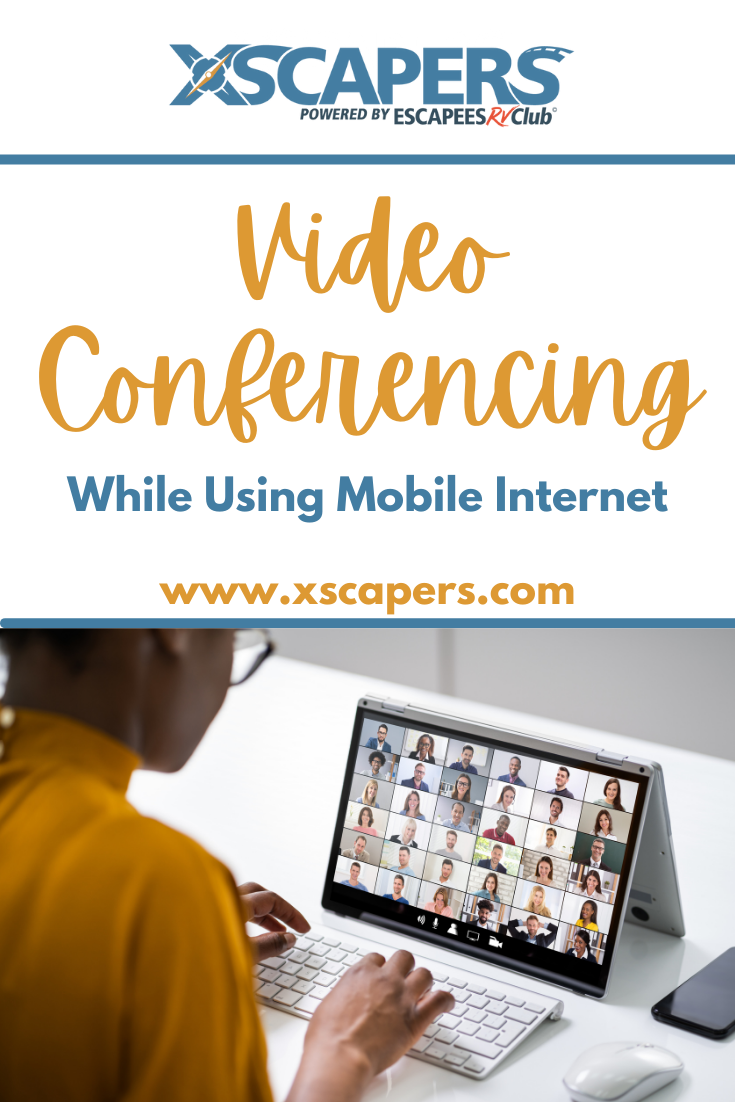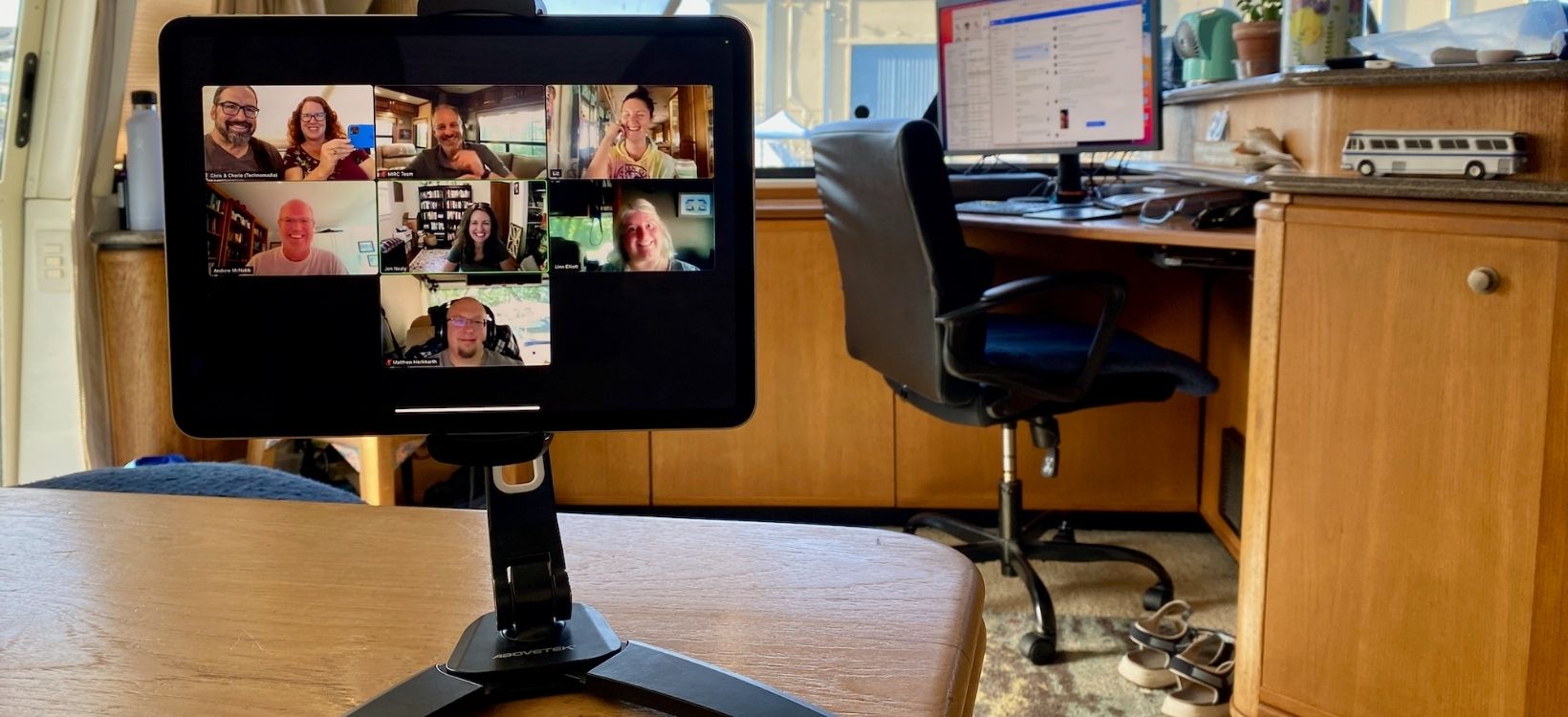Video Conferencing While Using Mobile Internet
If you’re living and working on the road, using video conferencing is likely going to be part of your online activity. Whether you’re Zooming with co-workers or Skype-ing with your family, we’ve got some information to ensure you have a smooth experience.
Broadcasting & Conferencing Services
 There are many options out there for broadcasting video as well as video conferencing services, with different levels of efficiency and performance.
There are many options out there for broadcasting video as well as video conferencing services, with different levels of efficiency and performance.
Some video broadcasting options include YouTube Live, Facebook Live, and Twitch. These options are best used when you are just broadcasting a feed to an audience, with little or no interaction back from your audience.
Video conferencing tools are used when you want to interact with your communication partner. These might be used when you’re wanting to catch up with family and friends, or perhaps for meetings with coworkers. Tools for this option include Zoom, Skype, Microsoft Teams, and FaceTime.
Tips for Getting the Best Performance
So what do you need to think about if you’re planning to video conference using mobile internet? Depending on your situation, here are the factors you should consider for the best results.
The Need for Speed
 Video requires a lot of bandwidth, and higher speeds assure a smoother experience. The higher resolution you have your video app set to, the more speed and data you will utilize.
Video requires a lot of bandwidth, and higher speeds assure a smoother experience. The higher resolution you have your video app set to, the more speed and data you will utilize.
Upload speeds play a much more prominent role than you might be used to for just watching video streamed from the internet, such as through Netflix, Hulu, or YouTube. Upload is the speed of the connection from your device back to the transmitting tower, and is typically slower than download speeds.
For upload speeds, over 500 kbps is the bare minimum that you should aim for when broadcasting. Over 1.5 Mbps is ideal for general use, and should work well for standard resolution video conferencing activity. If you want to utilize higher resolutions, you may need to aim for upload speeds over 5 Mbps, and even as high as 20 Mbps for 4K video broadcasts.
For download speeds, especially when doing interactive video conferencing, 1-5 Mbps is ideal, but again, for higher quality broadcasting, you’re going to want speeds in the 5-20 Mbps range.
Another thing to consider is ping time. Ping is the time in milliseconds it takes for a request from your device to reach its destination and to return, like the ping of a ship’s sonar. The higher the number, the slower the speed. Under 50 ms will be a fantastic and smooth feeling, under 100 ms will be tolerable. If your ping times are over 500 ms, your connection will probably not be very usable for interactive video conferencing.
If you have a slower connection, or have caps on your data plan to contend with – then make sure you have set your resolution to the lowest that is acceptable for your needs to save bandwidth.
Getting Better Speeds
 If you’re connecting to your internet source via cellular or Wi-Fi and feel that your connection isn’t fast enough, you may be able to use either a cellular or a Wi-Fi signal enhancing device to improve the strength of your connection.
If you’re connecting to your internet source via cellular or Wi-Fi and feel that your connection isn’t fast enough, you may be able to use either a cellular or a Wi-Fi signal enhancing device to improve the strength of your connection.
For a cellular connection, the two primary signal enhancing options are external cellular antennas and boosters.
A booster will typically have more impact on upload performance than download performance. So if you will be doing a lot of video broadcasting over cellular, the investment in a cellular booster can be worthwhile.
Antennas tend to be cheaper and can often produce better results in enhancing download speeds.
There are also devices you can purchase to improve a weak Wi-Fi connection. But, before trying to improve a Wi-Fi signal, make sure to test the Wi-Fi signal at its source. If the Wi-Fi signal is not very good to begin with, no amount of enhancement equipment is going to improve it.
The simplest option is sometimes to just try a different internet connection. If you have multiple cellular carriers onboard, then you can try another carrier, or even try using the Wi-Fi connection if you’re in a campground (sometimes public Wi-Fi does work well!). And if you have advanced routers, you may even be able to use features like bonding or autofailover to increase your reliability during video calls.
Additional resources:
Testing Your Internet Speeds – www.rvmobileinternet.com/tv
The Importance of Redundancy – www.rvmobileinternet.com/redundancy
Understand the Limits on Your Data Plan
 Your data plan may come with a large chunk of high speed data, or maybe even unlimited data. But very often these plans come with limitations on how the data can be used.
Your data plan may come with a large chunk of high speed data, or maybe even unlimited data. But very often these plans come with limitations on how the data can be used.
The biggest gotchas tend to be caps on mobile hotspot use, which is the type of data you would use to share data with devices like your computer or smart TV. Most data plans on the market include a limited amount of high speed data that can be shared with other devices – typically in the 15-100GB per month range.
Video conference and broadcasting can easily burn through 1-4 GB per hour, depending on video resolution.
One way to avoid data caps is to utilize a cellular enabled tablet for connected activities. Tablets have built-in cameras, microphones, and speakers making them ideal video conferencing and broadcasting appliances. Most video services also offer tablet apps. And, every cellular data provider offers affordable unlimited on-device data plans for tablets, sometimes as low as $10-30/month when added on to an existing smartphone plan.
Whether shopping direct with the carriers, via prepaid services, or going with 3rd party unlimited resellers – be sure to pay attention to the terms of the plan.
For tracking the current top pick data plans, start with our guide at:
Top Pick Data Plans for RVers – www.rvmobileinternet.com/planpicks
Summary
As more and more travelers hit the road, using mobile internet for broadcasting and video conferencing is becoming more and more common. It’s a great tool to use for keeping in touch with friends, family, and coworkers.
Making sure you have an understanding of the basic requirements for video conferencing and broadcasting and confirming that your mobile internet plans and equipment can meet these requirements will help make it easier to stay connected with everyone you need to while you’re enjoying the freedom of life on the road.
For more information on this topic, here’s our full guide:
Did you like this post? Pin it on Pinterest!


Author
Jen Nealy
Jen Nealy and her husband Deas were full-time RVers for 5 years and are now part-time vanlifers based in Asheville NC. Jen works for the Mobile Internet Resource Center.


 Previous Post
Previous Post Next Post
Next Post